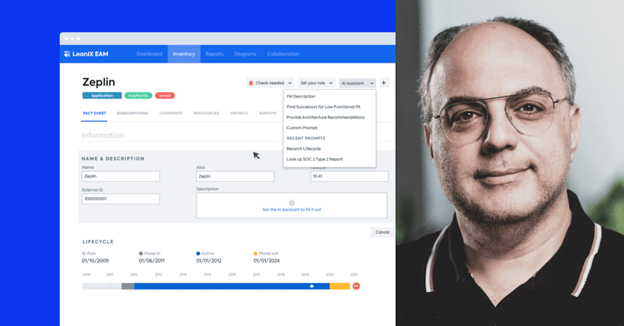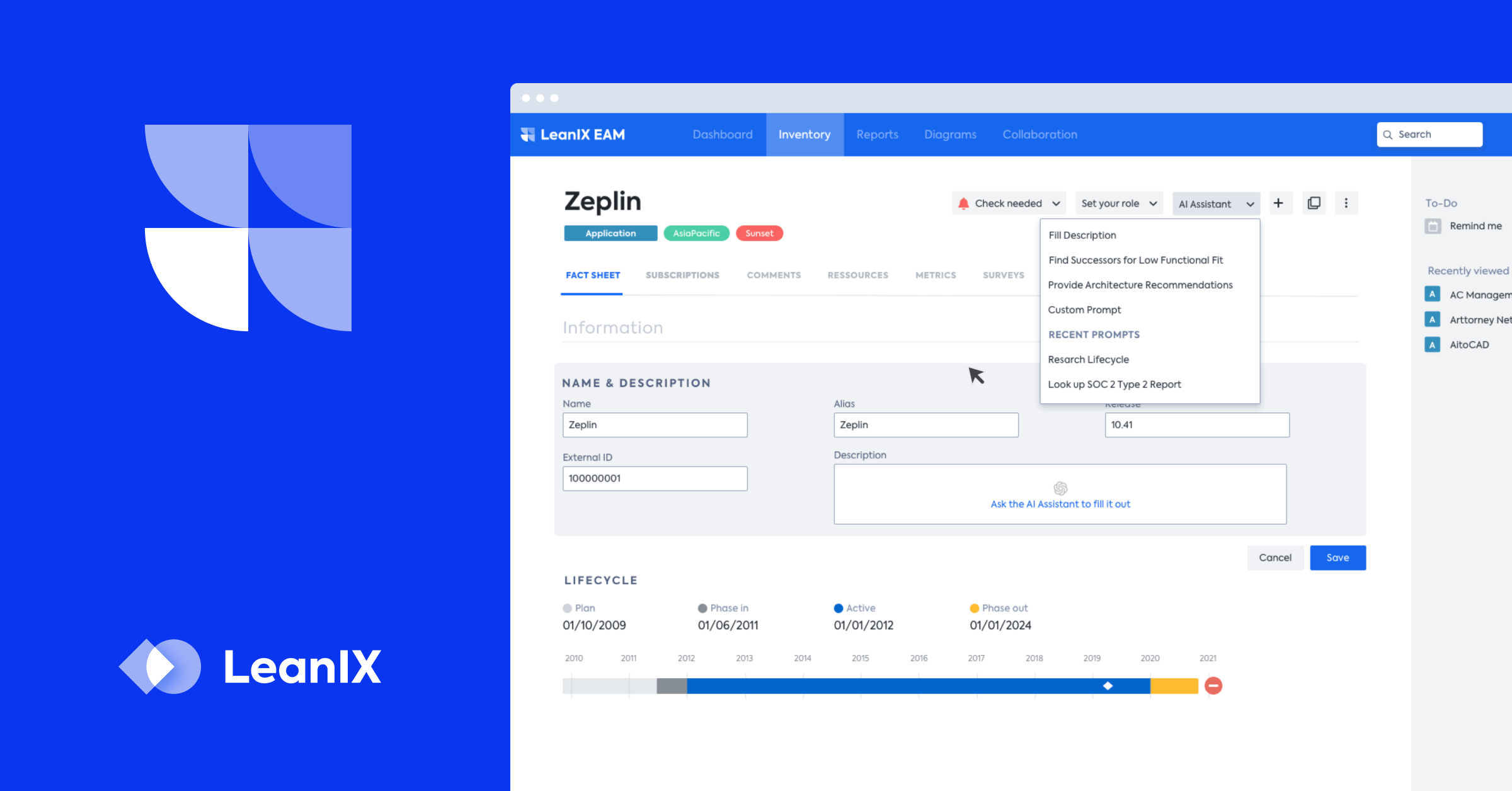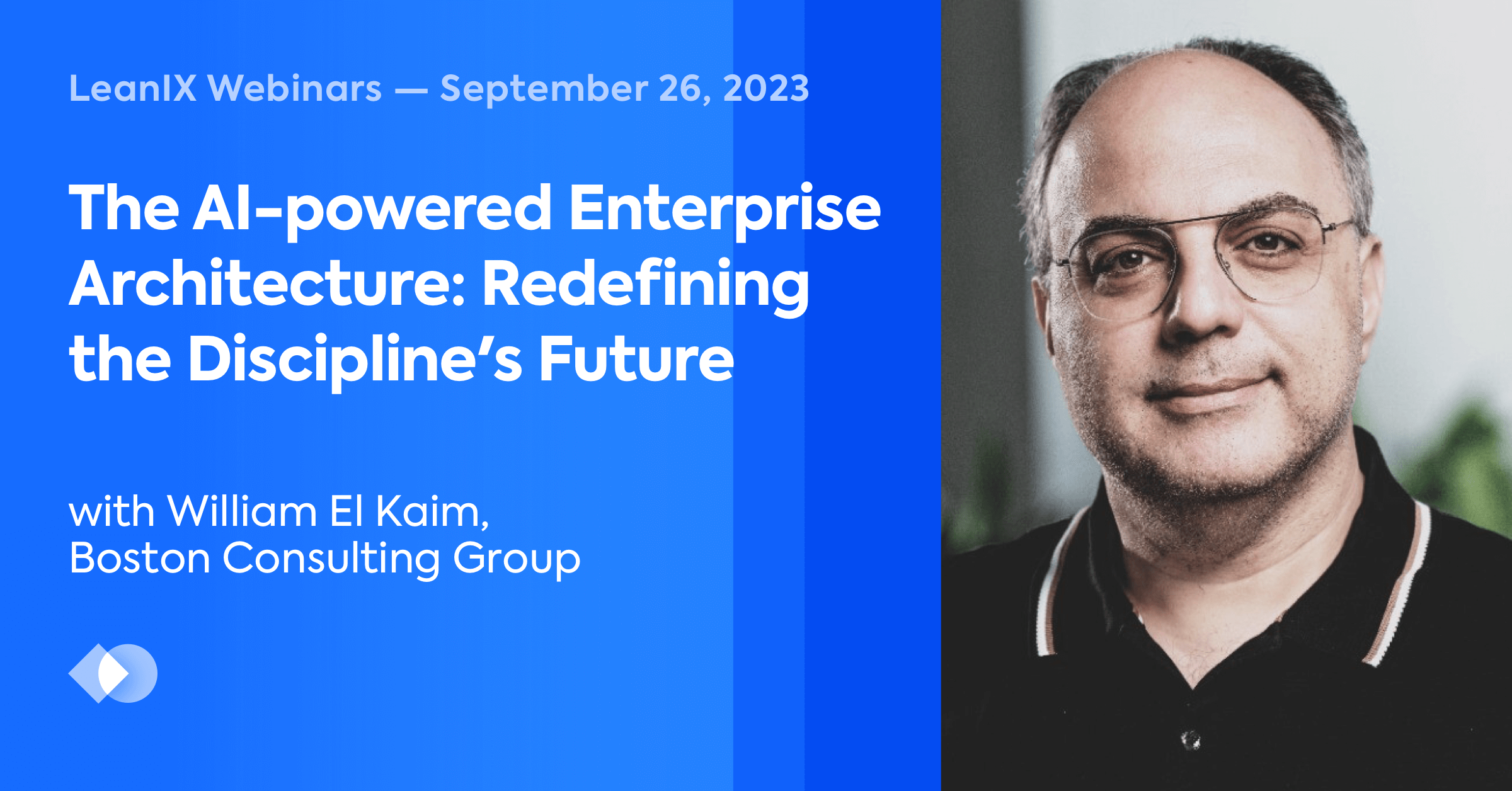
The potential for AI to empower the future of enterprise architecture was the topic of our recent webinar with BCG. Let's recap everything that was discussed in the session.
Enterprise architecture (EA) is one of the many fields set to be revolutionized by generative artificial intelligence (AI) tools like ChatGPT. EA, however, will also be key for helping organizations get the most from AI across their entire organization.
We recently hosted a webinar with William El Kaim, IT Architecture Director at Boston Consulting Group (BCG), on how enterprise architecture will be revolutionized by AI, and in turn, help AI to enhance a variety of other fields. Watch a recording of the entire session below:
To hear more from William, take a look at his blog on Medium.
Let's consider some of the topics discussed in the session and look more closely at what the advent of generative AI means for the future of enterprise architecture.
The Speed Of Progress
Introducing our webinar on how generative artificial intelligence (AI) will impact enterprise architecture, William from BCG began by explaining how AI has evolved over the years:
1956: Artificial Intelligence - the pursuit of machines that can replicate or exceed human intelligence
1997: Machine Learning - allowing AI to process existing data to derive insights and make accurate decisions and predictions
2017: Deep Learning - advanced machine learning using neural networks
2021: Generative AI - using deep learning to create text, visuals, and audio from existing data
2022: ChatGPT - a generative AI with a chat interface, allowing users to type questions and receive answers
William explained how these innovations are powering enterprise architecture:
"I just discovered how powerful generative AI can be for helping me as an architect to do my job... It provides already some key opportunities for improvement of our existing tooling and also a change in our way of working and thinking."
William El Kaim, IT Architecture Director, BCG
Less A Car, More A Horse
One thing that's clear from the above is how quickly things are progressing. Not just generative AI, but the potential applications of it, are developing at pace.
Generative AI systems like ChatGPT ingest huge amounts of data from various sources, primarily the internet, in order to learn how language and imagery work. You can then enter a prompt, such as a question or description, and the AI will generate an original, unique response that is similar to other human responses to those prompts.
In other words, you can ask ChatGPT to explain quantum mechanics to you in a very simple way, or draw a tree, or create a recipe for cookies. The AI can then immediately generate the answers, images, or information that you need.
William explained that the greatest change in our thinking that generative AI will bring about is the need to manage an evolving system. Generative AI continues to learn from new information and the successful content it generates, meaning it will continue to evolve in ways we can't predict.
Rather than discovering a challenge for your organization and building a solution to that problem, generative AI is a self-actualized tool that will adapt itself to support your business needs, perhaps faster than you can understand them.
Leveraging ChatGPT is less like driving a car where you want it to go, and more like breaking in a horse. While we must adapt to a loss in complete control, a horse may see and avoid hazards in the road that we ourselves would have missed.
"[AI is] not really adapted today for really deep thinking, it's more a way to aggregate, integrate, and manage [tasks] in a better way, but also sometimes to propose some key co-piloting of your current task to support you with some of the elements that we're teaching to the model."
William El Kaim, IT Architecture Director, BCG
Moderating Generative AI
Of course, while there is an advantage to the pro-active capabilities of generative artificial intelligence (AI), there is also risk. Generative AI can only predict the most likely response to a prompt, it cannot confirm the validity of the answer.
Occasionally, generative AI platforms have been known to 'hallucinate', creating answers to questions that simply sound plausible, but are not, in fact, correct. To avoid this, we must build in guardrails and monitoring systems to protect users from misinformation.
To do this, as well as to leverage generative AI in general, enterprise architects need to rapidly adapt their way of thinking and working. From new programming languages developed for AI, to completely AI-driven architecture models, there's no doubt that enterprise architects will have to learn new skills to survive.
Here, William referenced the new LeanIX Meta Model, which acts as a template for our customers to use to create an optimal enterprise architecture. Our latest Meta Model includes a map of where AI can fit into your IT landscape.
"Now we know how to represent an application and build a generative AI, the question is: what can generative AI do for me as an enterprise architect...?"
William El Kaim, IT Architecture Director, BCG
The Value Of AI In Enterprise Architecture
Enterprise architecture is one of the industries that will benefit the most from the support of generative artificial intelligence (AI) tools. William cited five key areas where AI can support enterprise architects:
- Minimize the time spent on low-value tasks and increase presence and collaboration between the business and IT
- Reduce time and effort needed to govern architecture and technology at the enterprise level
- Improve quality of analysis using up-to-date IT landscape data
- Ensure best compliant architecture using guided design and automated model generation
- Accelerate the transfer of knowledge, training efforts, and bridging skill gaps
The key here is time. With AI as your co-pilot, you can delegate simple tasks, communication, and quality checks, and concentrate on the tasks that create real value for your organization. Yet, this is just one of the potential uses for AI.
Enterprise Architecture
Generative artificial intelligence (AI) can act as a co-pilot for enterprise architects in taking on simple tasks, but there are two other capabilities that enterprise architecture can leverage, according to William. It can ease ingestion and become a polyglot.
Ease Ingestion
AI can automate information crowdsourcing, both internally and externally. In addition, AI can then validate that information, improve data quality, and help to collate it for you.
Become A Polyglot
Generative AI has the ability to rapidly learn about any topic or field. This means you can access the language and logic of any discipline to support your research.
"What is also interesting, and that's something that LeanIX has already implemented, it can give you an opinion about the architecture you provided it. So, it's able to understand, thematically, what you've provided, and is also able to provide some recommendations... Most of them will make sense and some of them will not make sense, but it's also a good way to test yourself and to see, finally, what's interesting and what's not."
William El Kaim, IT Architecture Director, BCG
The Augmented Enterprise Architect
So, what will the enterprise architecture of the future be like? To William, enterprise architecture will become an IT control tower, providing a coherent, up-to-date, unified view of the current state of the business and IT, and then evolving both using a scenario-based approach.
These future enterprise architects will be empowered by generative artificial intelligence (AI), which will perform key tasks under the architect's direction. AI will ease ingestion, act as a polyglot, and assist as a co-pilot, but the architect will always remain in control.
Governing the IT landscape, enterprise architects will also look at application modernization and leveraging innovation. As such, they will be the ones driving the AI transformation of other business capabilities.
The enterprise architecture function should, therefore, be the first department in your organization to embrace AI innovation, and become a champion for AI use across your business. From there, enterprise architects will become more important than ever as the people bringing AI innovation to your IT landscape.
The LeanIX AI Assistant

LeanIX and BCG see the importance of generative artificial intelligence (AI) for the future of enterprise architecture, which is why we ended our webinar with a demonstration of the capabilities of our LeanIX AI Assistant for enterprise architecture management.
We're excited to announce that the AI Assistant beta program is now available to all LeanIX EAM users. To join the program, follow the link below:




.png?width=140&height=107&name=BTMPlaybook-FI%20(1).png)

